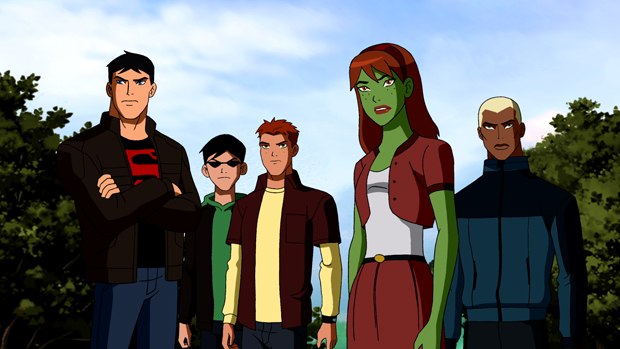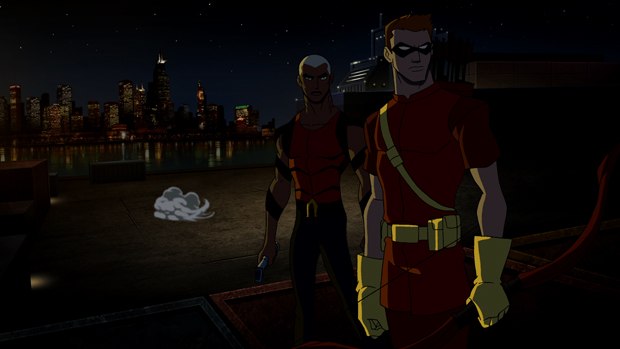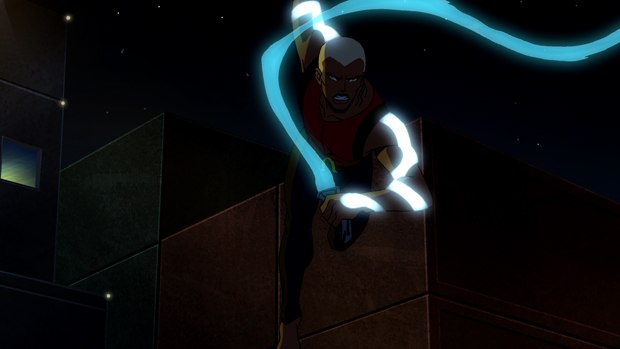The creators of Young Justice talk about setting a new bar for realism.
Check out clips from Young Justice on AWNtv!
Young Justice, airing Fridays on Cartoon Network (7/6c), is a cross between Teen Titans and Young Justice, but obviously with a more contemporary and realistic take. Animated by Warner Bros. Animation and MOI Animation Inc. in Seoul, Robin, Kid Flash, Superboy, Miss Martian, Aqualad and Artemis (joining in episode six) inhabit a whole new world of adolescent superheroes and their conflicts. In this week's third episode ("Welcome to Happy Harbor"), for example, Speedy declines to join the new team, so Robin, Aqualad and Kid Flash fear Young Justice is a big joke, while new recruit Miss Martian isn't sure there's room for her. Their fears are realized when they come up against Mister Twister. Creators Greg Weisman (Gargoyles) and Brandon Vietti (Batman: The Brave and the Bold) divulge more.
Bill Desowitz: What is Young Justice all about?
Greg Weisman: It's a show about teenagers coming of age. All teenagers have something to prove to teachers, parents, peers, mentors and, most especially, themselves. If you take that and amp it up exponentially because these particular teenagers happen to be superheroes. They're young; the DC universe they're playing in is relatively young. That is, Superman's only been active for about 10 years; Justice League was only formed about four years ago. Superheroes are still unique and these kids have to figure out for themselves how they fit into that world, if at all.
BD: And who are some of the villains?
GW: They fought Blockbuster; they are fighting Mr. Twister. We haven't named a lot of the villains yet but in the episodes to come we'll be seeing Bane and Cobra and Black Manta and a whole lot more. We've got 170+ characters -- heroes, villains, supporting characters -- all from the DC universe across the 26-episode season. So you're going to be seeing a lot different characters as the season progresses.
Brandon Vietti: One of the major themes for our series is "Secrets and Lies," and so holding back who are villains are going to be is part of maintaining that secrecy. The audience will see at the end of episode two that the villains are purposely remaining in the shadows. We want you to follow along and guess who they might be. There's a master plan that we've got about revealing them.
BD: What were some of the basic challenges in creating Young Justice?
BV: From the very beginning, Greg and I wanted to make the show as realistic as we possibly could to differentiate our show from the other great DC shows that came before us. Again, these are young superheroes and they are taking on more grown-up missions from their adult mentors. For instance, Batman is now putting them on missions that he may have protected them from in the past. So you've got this collision of young heroes now taking their next step to adulthood, and we wanted those moments to feel [authentic]. To help along with that, we've put a lot of thought into the design. Our character designer, Phil Bourassa, has a real sharp eye for drawing in a more realistic manner that's animation friendly. So we've carefully tailored the outfits of the individual characters. It was very important that they all don't seem like they wear spandex and shop at the same superhero outfit clothing store. And Robin works with Batman on the streets, so you see a lot of seams in his outfits to make it seem like he's got some armoring and padding to protect himself in street fights. Aqualad needs a more streamlined outfit to cut through the water quickly. Backgrounds and the painting style are also more realistic. All of these artistic choices, again, support the kind of stories we're trying to tell.
BD: Let's talk about the Earth-16 universe you've introduced.
GW: I think the key is that you're obviously going to see some stuff that's familiar if you're a DC Comics fan. But you can't count on anything being the same: it's a parallel universe with a lot of differences. We won't deny that creatively we conflated errors quite a bit to modernize this and bring characters together that were introduced in completely different eras, ranging from Dick Grayson, who debuted in 1940, to Miss Martian, who debuted much more recently, obviously. But the idea is to try and create something coherent that still has this iconic feel to it but is also very contemporary. So we asked DC if we could have an earth -- and they gave us Earth-16.
BD: How does this realistic approach extend to the animation?
BV: I think visually our influences live-action film based. We're not trying to look graphic or comic-booky with shots. I can't point to anything specific, but it really depends on the storyboard artist or the director.
BD: Who are some of the directors you're working with?
BV: Michael Chang from The Brave and the Bold; Jay Oliva, who we've worked with for years and has storyboarded almost all of the direct-to-video movies. I hired them because we all have some of the same interests and influences and I knew their strengths and that this project was a great fit for them. They have a strong handle on how to direct in a more realistic manner and, like all of us, they were looking for a new way to do something they we've all done a lot. When Greg and I plot stories, we write about superheroes in a way that's never been done before. We want to make it new for us and the audience. And our directors had the same challenge: How do we create these superhero shows in a visual way that's going to feel new to our audience.
BD: What are some examples?
GW: Well, in episode four -- "Drop Zone, "which is their first official mission from Batman, he sends them to a rogue country to investigate the production of a neo steroid called Venom. This puts them in the middle of a minor war between Bane and the Cult of the Cobra. We've got a lot of character stuff coming. We've got a lot of humor, romance, drama, tragedy and lots of action, obviously.
BD: How hard is it juggling all of this?
BV: Its' really hard (laughing).
GW: We've got a main cast of six but the supporting cast is immense and we've wanted to give real nice moments to these characters, including Red Tornado, Batman and Black Canary, who are the three adult heroes most involved with these teens. Red Tornado lives in a cave with Superboy and Miss Martian; Batman assigns them their missions; and Black Canary is in charge of their training. But we also have a major subplot for Zatara, the magician hero, Captain Marvel and other teen heroes we meet as the series progresses. The world is ever-expanding.
Bill Desowitz is senior editor of AWN & VFXWorld.











